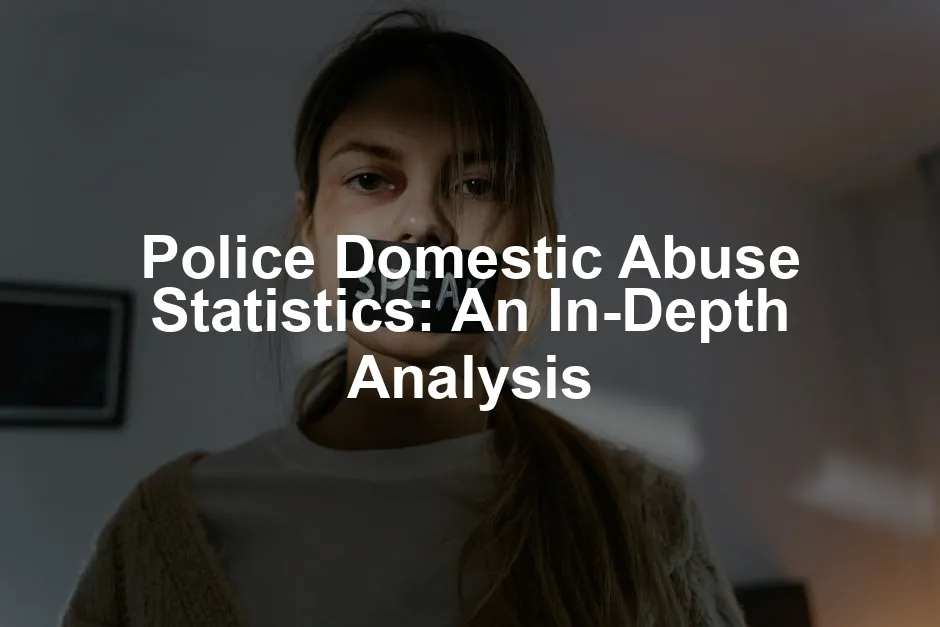Introduction
Police domestic abuse statistics hold significant weight in understanding the complexities of domestic violence within law enforcement. These statistics are crucial for several reasons. First, they help illuminate the prevalence of domestic abuse among those sworn to uphold the law. When officers, often seen as protectors, are implicated in such heinous acts, it raises serious questions about the integrity of the system itself.
Understanding the prevalence of domestic abuse within law enforcement is essential for community trust. If police officers are reported to be involved in these incidents, it undermines public confidence in their ability to enforce the law fairly and judiciously. Moreover, it highlights the urgent need for effective intervention strategies and support systems for victims, especially those who may feel trapped in a cycle of violence with an officer.
If you’re looking to better understand the psychological aspects of such violence, consider reading “The Gift of Fear: Survival Signals That Protect Us from Violence” by Gavin de Becker. This book provides insights into recognizing danger and protecting oneself, which is invaluable for victims and their supporters.
However, the landscape of police domestic abuse statistics is fraught with controversy. Many figures, especially the widely cited statistic that claims 40% of police families experience domestic violence, have come under scrutiny. Critics argue that such numbers are outdated and misleading, based on studies from as far back as the early 1990s. Recent discussions suggest that the actual figure may be much lower, with estimates indicating that only about 1% of police officers are involved in domestic abuse incidents. This discrepancy underscores the need for accurate, current data to inform policy and protect victims effectively.

Understanding police domestic abuse statistics is crucial for addressing the issue effectively. Learn more about the statistics surrounding police domestic abuse.
The complexities of data collection and reporting practices within police departments further complicate the situation. Many incidents go unreported due to fear of retaliation or a lack of trust in the system. Therefore, it’s critical to analyze and discuss these statistics carefully, ensuring we understand not only the numbers but also the narratives behind them.
Understanding Domestic Abuse
Definition of Domestic Abuse
The Domestic Abuse Act 2021 provides a comprehensive definition of domestic abuse. It encompasses any incident or pattern of incidents of controlling, coercive, or threatening behavior, violence, or abuse. This abuse can occur between partners, ex-partners, relatives, or individuals with a parental relationship concerning the same child. The Act recognizes various types of abuse, including physical, emotional, psychological, economic, and coercive control.
Physical abuse is perhaps the most recognizable form, involving acts of violence that cause bodily harm. However, emotional and psychological abuse can be just as damaging. These forms often involve manipulation, intimidation, and threats, creating an atmosphere of fear and helplessness. Economic abuse restricts a partner’s access to financial resources, thereby controlling their independence. Coercive control, a more recent addition to the definition, involves a persistent pattern of controlling behaviors that restrict a victim’s freedom.
To help you navigate the challenges of emotional and psychological abuse, I recommend “The Body Keeps the Score” by Bessel van der Kolk. This book delves into how trauma affects the mind and body, offering insights for recovery and healing.

Prevalence of Domestic Abuse
Domestic abuse is a widespread issue, affecting millions across society. General statistics indicate that 1 in 4 women and 1 in 6 men will experience domestic abuse at some point in their lives. Alarmingly, the police receive a domestic abuse-related call every 30 seconds. However, when we compare these figures to those of police officers, the narrative shifts.
Research has shown that domestic abuse occurs at a higher rate among police families compared to the general public. While estimates vary, some studies suggest that domestic violence rates among police families could be as high as 28%. This stark contrast raises numerous questions about the culture within law enforcement and the factors contributing to this troubling trend.
Understanding the prevalence of domestic abuse in police families is vital for addressing the issue effectively. It not only emphasizes the need for better support systems but also calls for a closer examination of the police culture that may allow such behavior to persist. The statistics tell a story that demands attention and action to ensure the safety and well-being of all individuals, regardless of their relationship to law enforcement.

Historical Context and Current Statistics
Overview of Historical Data
Domestic abuse within police families has a complex and troubling history. Research dating back to the early 1990s suggested that domestic violence was alarmingly prevalent among police families. One of the most cited statistics claimed that a staggering 40% of police officer families experienced domestic violence. This figure has been criticized for its age and methodology, leading many to question its validity in the current context.
The foundational studies included the work of Johnson and Neidig, which highlighted significant rates of domestic violence in police households. Johnson’s research indicated that a shocking 40% of surveyed officers reported engaging in violent or abusive behavior towards their partners. Meanwhile, Neidig’s findings suggested that up to 28% of male officers admitted to inflicting some form of violence on their spouses. Such statistics painted a grim picture of the internal culture within law enforcement.
However, these findings are heavily debated. Critics argue that the definitions of domestic violence used in these studies were often narrow and did not account for emotional or psychological abuse. The context in which these studies were conducted also raises concerns about representativeness. The reliance on self-reporting can lead to underreporting, as many individuals may feel hesitant to disclose abusive behaviors due to shame or fear of repercussions.

For a deeper understanding of the psychological impact of domestic violence, I suggest reading “Why Does He Do That?: Inside the Minds of Angry and Controlling Men” by Lundy Bancroft. This book provides insight into the mindset of abusers and the complex dynamics of control in relationships.
Recent Data and Trends
Fast forward to recent years, and the conversation around domestic abuse in police families has evolved. New statistics from credible sources, including the Office for National Statistics (ONS) and various domestic abuse commissioners, indicate a shift in both reported incidents and societal attitudes toward these issues. In the year ending March 2023, police recorded a total of 889,918 domestic abuse-related crimes in England and Wales, reflecting a troubling consistency in reported incidents.
Interestingly, while the number of reported domestic abuse incidents remains high, a new counting methodology introduced by the Home Office in June 2023 has sparked debate. This system directs police to count only the most serious offense in instances where multiple crimes are reported. As a result, it has been suggested that the apparent decrease in recorded domestic abuse incidents—a 10% decline compared to previous years—may not accurately reflect a reduction in domestic violence itself.
Instead, this change in reporting could indicate that fewer incidents are being documented due to the new rules, casting doubt on the reliability of the statistics. Nicole Jacobs, the Domestic Abuse Commissioner, has voiced concerns, emphasizing that these changes might undermine the efforts to accurately understand and address domestic violence.
In Scotland, the police recorded 61,934 incidents of domestic abuse in 2022-23, marking a 4% decrease from the previous year. However, 61% of these incidents did not involve any recorded crime, suggesting that many incidents may go unrecognized or unreported. The gender dynamics within these statistics reveal that 83% of victims were female, and 81% involved male suspected perpetrators, indicating a persistent trend in domestic abuse patterns.
The ongoing challenges surrounding domestic abuse statistics underscore the need for continued scrutiny and reform within policing practices. As we seek to understand the dynamics of domestic violence in police families, it becomes increasingly clear that both historical and current statistics play a critical role in shaping the narrative and driving systemic change.

Discrepancies and Controversies in Statistics
Examination of Controversial Claims
The statistic claiming that 40% of police officers’ families experience domestic violence has been a subject of heated debate. Critics argue that this figure is outdated and misleading, especially considering newer research suggesting that the actual rate may be significantly lower. Recent discussions pinpoint a figure closer to 1% or even 0.2%, questioning the accuracy of the earlier claims.
A 2019 analysis revealed that out of approximately 800,000 police officers in the United States, only about 230 were officially recognized for domestic abuse-related offenses annually, translating to a mere 0.2%. Such stark contrasts between the historical and contemporary data raise critical questions about the factors influencing these statistics.
Moreover, inconsistencies in data collection methodologies contribute to the confusion surrounding domestic abuse rates among police families. Many reports rely on self-disclosed data, which can be influenced by various biases, including fear of repercussions or a lack of trust in the reporting system. The absence of comprehensive, systematic data collection makes it challenging to draw reliable conclusions about the prevalence of domestic abuse within law enforcement.
The disparity between the 40% claim and more recent estimates indicates a need for improved transparency and accountability within police departments. Historically, the culture surrounding law enforcement has often discouraged reporting incidents of domestic violence, resulting in underreported cases. This silence contributes to a lack of accurate data and hampers efforts to address the issue effectively.
As the conversation around domestic abuse in police families continues to evolve, it is essential to critically evaluate the sources and methodologies behind these statistics. Understanding the discrepancies and controversies surrounding domestic abuse data will aid in developing more effective policies and support systems for victims within the law enforcement community.

Analyze the Limitations in Data Collection and Reporting Practices within Police Departments
When it comes to police domestic abuse statistics, the glaring issue of underreporting rears its ugly head. Why do we see so few incidents reported? The reasons are multifaceted and deeply rooted in the culture of law enforcement.
Firstly, fear of retaliation plays a significant role. Many victims hesitate to come forward, fearing that their abuser might retaliate, especially if that abuser is a police officer. Imagine living in a world where the very person meant to protect you also poses a threat. The idea of seeking help can feel like stepping into a lion’s den.
Stigma also compounds the issue. Victims often worry about being judged or not believed, leading to a culture of silence. This silence is deafening, creating an environment where domestic abuse can fester unchecked. It’s like being in a room filled with people whispering, but no one is brave enough to speak up.
Moreover, there’s a potential bias within law enforcement itself. Officers are often reluctant to report their colleagues, creating an internal code of silence. When the perpetrators wear a badge, the lines between right and wrong blur. The fear of complicity or backlash from fellow officers can deter victims from reporting their experiences.
The combination of fear, stigma, and bias creates a perfect storm for underreporting. This not only skews the statistics but also hinders effective intervention strategies. Without accurate data, how can we expect to address the problem effectively?
To truly understand the dynamics of domestic abuse in police families, we must confront these limitations in data collection. The statistics we often see are just the tip of the iceberg, obscuring the real magnitude of the issue. As long as these barriers exist, victims will continue to suffer in silence, and the cycle of abuse will persist.

Gender Dynamics and the Impact of Domestic Abuse
Gender dynamics play a crucial role in understanding the prevalence of domestic abuse, particularly within police families. The statistics are eye-opening: a significant portion of domestic abuse victims are women, and a substantial number of officers implicated in these incidents are male.
In the broader societal context, 84% of domestic abuse victims are female, while 93% of defendants are male. These figures suggest a stark gender disparity in both victimization and perpetration. When it comes to police families, the data mirrors these trends, with studies indicating that approximately 28% of police officers may engage in domestic violence compared to 16% in the general population.
Such disparities raise questions about societal attitudes towards male and female officers involved in domestic abuse. Male officers may face less scrutiny or be afforded more leniency than their female counterparts, contributing to a culture where their actions go unchecked. This differential treatment can deter victims from reporting incidents, fearing that their concerns will be dismissed or minimized.
What’s more, there’s the pervasive notion of “the protector.” Society often views police officers as guardians of safety, which complicates the narratives surrounding domestic abuse. Victims may feel disloyal for implicating an officer in such serious wrongdoing, adding another layer of complexity to an already fraught situation.
In conclusion, understanding gender dynamics is essential for addressing domestic abuse within police families. The statistics reveal a troubling reality, underscoring the need for systemic changes in how these cases are handled. Victims deserve to be heard, believed, and supported—regardless of the gender of the perpetrator. Only through acknowledging these dynamics can we hope to foster a safer environment for all.

Impact on Families and Communities
Domestic abuse within police families sends shockwaves through society. When officers, tasked with maintaining law and order, are involved in such behavior, it raises eyebrows and diminishes community trust. Families of law enforcement personnel may experience unique challenges. The stigma surrounding domestic abuse often keeps victims silent, leading to a cycle of dysfunction and fear.
The implications extend beyond family dynamics. Communities rely on police for protection and safety. When officers are implicated in domestic abuse, the very fabric of trust begins to fray. Citizens may feel hesitant to report crimes, fearing that the very individuals who are supposed to protect them are also potential threats. This erosion of trust can have lasting effects, making it increasingly difficult for police departments to engage positively with the communities they serve.
Moreover, the psychological impact on children in these households can be profound. Witnessing domestic abuse can lead to long-term emotional and behavioral issues. Children may grow up believing that such behavior is normal, perpetuating a cycle of violence. This cycle poses a significant risk not only to the immediate family but also to the broader community, as these children may later become perpetrators or victims themselves.
Thus, addressing domestic abuse within police families is not just a matter of internal department policy. It is a societal issue that calls for robust intervention strategies. These strategies must foster an environment where victims feel safe to come forward. Community outreach programs and transparent reporting processes can help rebuild trust. Ultimately, bolstering support for victims within police families can lead to healthier homes and safer communities.

Case Studies and Real-Life Examples
Notable Incidents
The intersection of domestic abuse and law enforcement has led to several notable incidents that cannot be overlooked. One high-profile case involved a police officer in the UK who was accused of abusing his partner. Despite multiple allegations, he remained on the force, highlighting systemic issues within police accountability. The public outcry that followed this case ignited discussions on how officers are treated compared to civilians when faced with similar accusations.
Another significant incident involved an officer who was convicted of domestic violence against his spouse. He received a minimal sentence, and many questioned whether justice was truly served. The case raised alarms about the leniency often shown to police officers accused of domestic abuse. Critics argue that such outcomes send the wrong message to both officers and the community—that some may escape serious consequences due to their badge.
In the U.S., a similar pattern emerged when a police department faced scrutiny for not suspending officers accused of domestic violence. Reports indicated that many remained on duty, creating an environment where victims felt unsafe. The statistics are alarming: a significant percentage of officers involved in domestic abuse cases continued to serve, often leading to further distrust within communities.
These incidents illustrate the pressing need for reform in how police departments handle domestic abuse allegations. They underline the importance of establishing independent oversight mechanisms to ensure accountability. Without these changes, the cycle of violence may continue, further eroding trust between communities and law enforcement.

Public Reactions and Media Coverage
Media coverage plays a crucial role in shaping public perception of domestic abuse within police ranks. When incidents come to light, the reaction from the public is often one of shock, disbelief, and anger. Coverage typically highlights the dual role of police officers as both enforcers of the law and perpetrators of domestic violence. This duality complicates the narrative, leading to a deeper scrutiny of police culture and practices.
News outlets often spotlight cases of domestic abuse involving officers, drawing attention to the broader implications for community safety. Investigative journalism has unearthed disturbing patterns—many officers accused of domestic violence continue to serve without facing appropriate consequences. Reports indicate that a significant number of these cases are dismissed or handled informally, raising concerns about systemic bias within police departments.
Moreover, social media has amplified public discourse surrounding these issues. Hashtags and campaigns advocating for police accountability have gained traction, mobilizing citizens to demand change. Public sentiment often leans towards supporting victims and holding law enforcement accountable. This shift in perception can lead to increased pressure on police departments to address domestic abuse more transparently and effectively.
The media’s portrayal of domestic abuse within police families not only informs the public but also influences policy discussions. Advocates argue for better training, oversight, and resources to support victims. As communities continue to grapple with these revelations, ongoing media coverage will be essential in maintaining awareness and advocating for necessary reforms. A united public front can ultimately drive meaningful change, ensuring that police forces prioritize the safety and well-being of all individuals they serve.

Recommendations for Improvement
Policy Changes
To tackle domestic abuse within police departments, substantial policy changes are crucial. First, departments must implement clear, strict protocols for handling domestic abuse allegations against officers. This includes mandatory reporting systems that ensure all claims are taken seriously and investigated thoroughly. A zero-tolerance policy should be established for officers found guilty of domestic abuse, leading to immediate suspension or termination.
Another essential change is the establishment of independent oversight committees. These committees should consist of external experts who can review cases without bias. This would foster transparency and rebuild community trust. Officers should not investigate their colleagues; that’s like letting the fox guard the henhouse. Independent oversight helps ensure that investigations are fair and impartial, holding all officers accountable, regardless of their position.
Moreover, policies should include regular training sessions on domestic violence awareness for all personnel. Education can help officers recognize the signs of abuse and understand the impact it has on victims. Encouraging empathy among officers can lead to a more supportive environment for victims and a culture that does not tolerate abuse.

For those interested in understanding the broader psychological impacts of trauma, I recommend “The Trauma of Everyday Life” by Mark Epstein. This book provides insight into how everyday experiences can contribute to mental health challenges.
Community Engagement
Community involvement is vital for addressing and preventing domestic abuse effectively. Police departments should actively seek partnerships with local organizations that support victims. Collaborating with these groups can enhance outreach efforts and provide necessary resources for victims.
Educating the community about domestic abuse is equally important. Awareness campaigns can help dispel myths surrounding domestic violence and encourage individuals to report incidents. Workshops or community forums focusing on healthy relationships and the signs of abuse can empower citizens to take action.
Schools also play a pivotal role in educating young people about the importance of healthy relationships. Implementing programs that discuss domestic abuse can equip students with the knowledge to recognize and report abusive behaviors.
By creating a community that is informed and engaged, we can foster an environment where victims feel safe to come forward and seek help.

FAQs
What percentage of police officers are involved in domestic abuse?
Recent statistics indicate that the involvement of police officers in domestic abuse cases is significantly lower than the often-cited 40%. More current estimates suggest that around 1% of police officers are implicated in domestic abuse incidents, with some studies indicating even lower figures, such as 0.2%. This discrepancy highlights the need for accurate, updated data to better understand the issue.
Why do domestic abuse statistics differ among police forces?
Discrepancies in domestic abuse statistics among police forces can be attributed to varying data collection methods, reporting practices, and definitions of domestic abuse. Some departments may have more rigorous reporting standards, while others may experience underreporting due to fear or stigma associated with coming forward.
What resources are available for victims of domestic abuse?
Numerous resources exist for victims of domestic abuse, including hotlines, shelters, and counseling services. Organizations such as Refuge and Women’s Aid provide essential support and guidance for those in need. Victims are encouraged to reach out for help, as support is available.
How can communities support victims of domestic abuse in police families?
Communities can support victims of domestic abuse by fostering a culture of understanding and compassion. Programs that educate the public about domestic violence, combined with outreach initiatives that connect victims to resources, are vital. Additionally, creating safe spaces for victims to share their experiences can help break the silence surrounding this issue.
Please let us know what you think about our content by leaving a comment down below!
Thank you for reading till here 🙂
All images from Pexels




